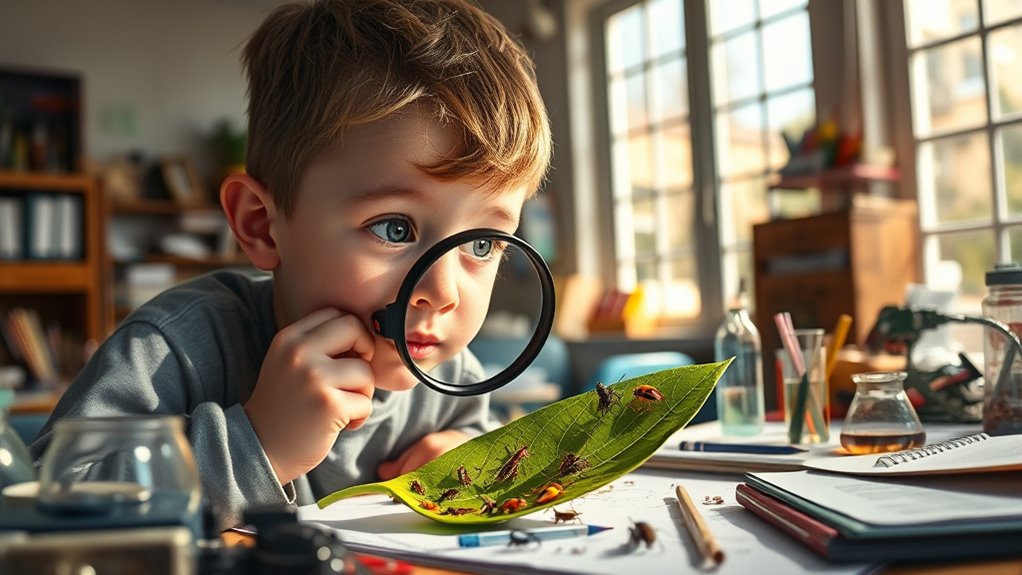To encourage curiosity, ask open-ended questions and create a safe space for exploration. Incorporate hands-on activities and real-world problems that relate to interests. Promote active inquiry by welcoming questions and viewing mistakes as learning opportunities. Use diverse resources, like videos or guest speakers, to spark interest. Encourage trying new activities and perspectives. This approach helps ignite a love of discovery—if you keep exploring, you’ll discover even more ways to inspire curiosity.
Key Takeaways
- Use open-ended questions to stimulate thinking and invite diverse responses.
- Incorporate hands-on activities and real-world problems to enhance engagement and relevance.
- Create a safe environment where mistakes are viewed as learning opportunities.
- Encourage active inquiry and curiosity-driven exploration without immediate answers.
- Foster social interactions and genuine interest to deepen interpersonal curiosity and discovery.
Understanding the Roots of Curiosity in the Brain

Understanding the roots of curiosity in the brain begins with recognizing that curiosity is driven by a desire to resolve uncertainty. When you encounter something unfamiliar, your brain signals a gap in knowledge, activating regions like the anterior cingulate cortex and anterior insula, which process discomfort from this uncertainty. This discomfort motivates you to seek answers, turning curiosity into a powerful motivator. Resolving your curiosity activates the brain’s reward system, including striatal circuits, making learning feel pleasurable. Additionally, curiosity enhances memory by engaging dopaminergic pathways and the hippocampus, helping you remember new information. Fundamentally, curiosity is linked to both the discomfort of not knowing and the reward of discovery, driving your desire to explore and learn more. On-device AI capabilities are also poised to influence how we explore and satisfy curiosity through personalized content and interactive experiences.
The Importance of Curiosity in Early Childhood Development

Curiosity plays a pivotal role in early childhood development, acting as a key driver of cognitive and social-emotional growth. It fuels learning by motivating children to explore, ask questions, and understand their environment. When you nurture curiosity, you help children develop essential skills such as problem-solving, creativity, and emotional regulation. Curiosity also promotes resilience, as children learn to navigate uncertainty and challenges. By encouraging their inquisitiveness, you support their social skills, like empathy and communication. Additionally, understanding electric bikes and their various features can inspire children to explore new technologies and innovations.
Strategies to Cultivate Curiosity in Educational Settings

Creating a learning environment that sparks students’ natural desire to explore can considerably enhance their curiosity. You can do this by providing open-ended questions that challenge their thinking and invite multiple answers. Incorporate hands-on activities and real-world problems to make learning more engaging and relevant. Encourage questions without immediately offering answers—this promotes active inquiry. Use diverse resources like multimedia, guest speakers, and field trips to stimulate different interests. Foster a safe space where mistakes are seen as learning opportunities, not failures. Recognize and celebrate curiosity-driven efforts to motivate ongoing exploration. By designing lessons that emphasize discovery and inquiry, you help students develop intrinsic motivation to seek out knowledge, transforming curiosity into a lifelong learning habit. Promoting cognitive flexibility in classroom discussions can further enhance students’ ability to adapt and explore new ideas.
The Role of Inquiry and Exploration in Science Learning

When you encourage inquiry, you ignite students’ natural curiosity about scientific concepts. Exploration prompts active engagement, helping learners connect ideas and deepen understanding. By fostering space for exploration, you make science learning more meaningful and memorable. Additionally, discussing topics like heat pump noise levels can help students understand how technological advancements enhance comfort and reduce environmental impact.
Inquiry Sparks Curiosity
Have you ever noticed how asking questions or exploring unknowns ignites a student’s interest in science? Inquiry fuels curiosity by encouraging students to seek answers and understand concepts deeply. When you create opportunities for exploration, you activate natural motivation, making learning engaging and meaningful. Inquiry prompts students to identify gaps in their knowledge and pursue solutions actively. This process not only sparks curiosity but also develops critical thinking skills essential for scientific understanding. Incorporating structured learning systems can further enhance this exploration by providing reliable frameworks for inquiry.
Exploration Enhances Learning
Exploration plays a crucial role in science learning by actively engaging students in the process of discovery. When you encourage exploration, you help students develop a deeper understanding of concepts through firsthand experiences. Instead of passively receiving information, they investigate, ask questions, and test ideas, which reinforces learning. This active involvement taps into curiosity’s neural rewards, motivating continued effort and retention. Exploration also helps students connect new knowledge to existing mental frameworks, making learning more meaningful. By creating opportunities for inquiry and hands-on activities, you foster an environment where curiosity thrives. When students explore the unknown, they become more confident, resourceful, and committed to learning. Additionally, fostering a bias to action mindset encourages students to make decisions swiftly and confidently, further enhancing their engagement with scientific inquiry. Ultimately, exploration transforms science education into a dynamic process that cultivates curiosity and promotes lasting understanding.
Navigating Age-Related Changes in Curious Behaviors

As you age, you might notice a decline in intellectual curiosity and openness to new experiences. These changes can make it harder to stay motivated to explore unfamiliar topics or ask questions. However, understanding how to support lifelong wonder can help you maintain a curious mindset at any age. Incorporating mindfulness practices can further enhance your ability to stay engaged and receptive to new information.
Decline of Intellectual Curiosity
Understanding how intellectual curiosity declines with age is essential for addressing lifelong learning challenges. As you get older, you may notice reduced interest in exploring new ideas or asking questions. This decrease can be linked to changes in brain chemistry, personality traits like openness, and fewer opportunities for novelty. Recognizing these patterns helps you develop strategies to maintain curiosity. For example, engaging in activities rich in antioxidants and new experiences can stimulate brain function and support curiosity. Fewer social or educational stimuli diminish curiosity triggers. Lifestyle changes may limit exposure to new ideas or challenges. Some curiosity forms, like interpersonal curiosity, remain more stable over time. Understanding these factors empowers you to foster curiosity at any age.
Age and Openness Shifts
Research shows that as you age, your curiosity—particularly intellectual curiosity—tends to decline. This shift often results from changes in brain structures associated with openness to experience, a trait linked to curiosity. As you grow older, you may notice less enthusiasm for exploring new ideas or asking questions. Neural pathways involved in novelty-seeking and information processing weaken over time, reducing your drive to seek out unfamiliar topics. However, not all curiosity fades equally; some forms, like social or interpersonal curiosity, remain stable or even increase. Understanding these changes can help you adapt your approach to learning. You can foster curiosity by engaging in new activities, seeking diverse perspectives, and embracing opportunities for social connection, which may help counteract declines in intellectual openness. Additionally, engaging in activities like aquatic exercise can stimulate your brain and support cognitive health, potentially encouraging ongoing curiosity.
Supporting Lifelong Wonder
Have you ever wondered how to maintain your curiosity throughout your life? Staying curious as you age requires intentional effort and mindset shifts. Recognize that curiosity can evolve rather than fade, adapting to your changing interests and capacities. Engage in new activities, seek diverse perspectives, and embrace learning opportunities at every stage. By doing so, you reinforce neural pathways associated with exploration and wonder. Incorporating mindfulness practices such as meditation can further enhance your awareness and openness to new experiences.
Fostering Interpersonal Curiosity for Better Social Connections

Fostering interpersonal curiosity is essential for building stronger social connections because it encourages genuine interest in others’ thoughts and feelings. When you ask sincere questions and listen actively, you signal that you value their perspective, which deepens trust. Showing curiosity about someone’s experiences helps break down barriers and creates a sense of understanding. To cultivate this curiosity, focus on being present and attentive, avoiding assumptions or judgments. Notice cues that reveal their emotions or opinions, and ask open-ended questions to explore further. Remember, curiosity about others isn’t just about gathering information; it’s about fostering empathy and emotional connection. By genuinely seeking to understand, you strengthen relationships, promote mutual respect, and create a supportive social environment.
Frequently Asked Questions
How Can Parents Effectively Nurture Curiosity at Home?
You can nurture curiosity at home by creating a supportive environment that encourages questions and exploration. Show genuine interest in your child’s ideas, provide diverse and engaging materials, and allow them to pursue their interests freely. Ask open-ended questions to spark thinking, celebrate their discoveries, and avoid rushing to answers. By modeling curiosity yourself and embracing new experiences, you inspire your child to explore and learn naturally.
What Are Common Barriers to Curiosity in School Environments?
Barriers to curiosity in schools act like walls blocking the path to discovery. Rigid norms and strict reward systems often suppress natural questioning, making students feel like explorers trapped in a cage. When teachers lack training on fostering curiosity, they miss chances to ignite students’ interest. Additionally, fear of failure and fixed mindsets discourage risk-taking. To break down these barriers, create a safe space where questions are celebrated and exploration is encouraged.
Can Curiosity Be Enhanced in Adults, or Is It Only for Children?
Yes, you can enhance curiosity in adults. You just need to create environments that foster exploration and reduce fear of uncertainty. Engage in new experiences, ask questions, and pursue learning opportunities that challenge you. Embrace a mindset of growth and openness. By actively seeking novel ideas and staying open to different perspectives, you stimulate your brain’s curiosity pathways, making exploration a natural and ongoing part of your life.
How Does Cultural Background Influence Curiosity Development?
Think of curiosity as a garden that needs different sunlight and water depending on your cultural background. Your culture shapes what questions feel safe or exciting to ask, influencing how curiosity blooms. Some cultures encourage exploration and questioning, making curiosity grow like a vibrant flower. Others may prioritize harmony or tradition, which can shade curiosity. So, your cultural roots deeply influence how curiosity develops and flourishes in your life.
Are There Specific Activities Proven to Boost Interpersonal Curiosity?
You can boost interpersonal curiosity through activities like active listening exercises, empathy-building role-plays, and open-ended discussions. Encourage questions about others’ feelings and perspectives, fostering genuine interest. Group projects and collaborative problem-solving also stimulate curiosity about peers’ thoughts. These activities create safe spaces for sharing, helping you develop a deeper understanding of others, ultimately strengthening social bonds and emotional intelligence through curiosity-driven engagement.
Conclusion
By nurturing curiosity, you gently open doors to endless possibilities and deeper understanding. Embrace the wonder that sparks in every question and exploration, knowing it’s a subtle invitation to growth. When you foster a curious mindset, you create a space where learning feels natural and exciting. Keep encouraging those small, yet meaningful, moments of discovery—every step forward is a quiet invitation to a brighter, more curious future.









